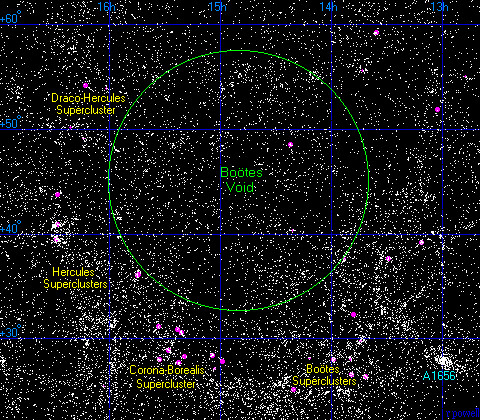
Cosmic voids, and supervoids, are large volumes of space that are devoid of matter. This includes normal matter, in the form of galaxies, and dark matter. Initially, astronomers were not sure if the voids contained dark matter, even though there were no galaxies, but recent observations show that the halos of dark matter are not present. The filamentary structure of galactic superclusters surrounds the voids. While space is mostly empty, voids are large volumes, tens of megaparsecs across. The largest confirmed supervoids are about 100 Mpc (325 million light-years) or more across . The larger known voids include the Boötes Supervoid, and the Northern and Southern Local Supervoids. To explain the cold spot in the cosmic microwave background (CMB), some astronomers propose a huge supervoid, tentatively dubbed the Eridanus or Great supervoid. The Capricornus void is another disputed void, but would be around 230 Mpc across. This link has some of the latest information on cosmic voids. – Whillyard
From NASA:
Boötes (boh-OH-teez) Void (or the Great Void, for the more dramatic), discovered in 1981 and located in the vicinity of the constellation of the same name. At 250 to 330 million light years across, the Boötes Void is one of the largest voids out there that we’ve discovered. So far 60 galaxies have been discovered in the Boötes Void and all of those are found in a tube shape running through the void.
From Ian Chant at Nautilus:
Given how absurdly vast the cosmos is, with its hundreds of billions of galaxies, picturing it isn’t easy. You might think it natural, for instance, to see all these galaxies as more or less evenly spread out across the Universe. But you’d be wrong. Following the Big Bang, 13.8 billion years ago, says Robert Kirshner, an astrophysicist at Harvard, matter began to spread out pretty evenly but then started to clump. Matter-rich places eventually became denser and denser, and as they formed and grew, so too did empty spaces. Check it out.
Those voids, despite filling up over 60 percent of the Universe, are hard to find, says Kirshner. He’s been looking for them since 1981, when he and his colleagues found the Bootes void, one of the largest known voids to exist.
Actually, they’re not completely hollow—matter in voids still manages to coalesce into dwarf galaxies on occasion. This fact presents astronomers with a unique opportunity to view uninterrupted galactic birth and development.
The thing is, there aren’t nearly as many such dwarfs as there should be.
This “‘void phenomenon,’” says Kreckel, “suggests that low mass void galaxy formation is somehow suppressed.” More.
One speculation offers “hypothetical particles like warm dark matter that are producing ‘regions that are quite devoid of gravitational seeds for structure formation,’ says van de Weygaert.”
Given that we have never found any dark matter at all, let alone warm dark matter, it might be more economical to say “we have no idea at present.”
See also: How do dark energy and dark matter relate to ID?
and
Copernicus, you are not going to believe who is using your name. Or how.
Also: Void? Nothing? Here’s Hugh Ross on that weasel word “nothing” in science and philosophy—it comes in nine varieties at least.
Follow UD News at Twitter!